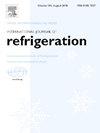An experimental investigation of secondary fluid parameters on heat pumps with higher temperature lift and zeotropic working fluid
IF 3.5
2区 工程技术
Q1 ENGINEERING, MECHANICAL
International Journal of Refrigeration-revue Internationale Du Froid
Pub Date : 2025-02-01
DOI:10.1016/j.ijrefrig.2024.11.034
引用次数: 0
Abstract
Heat pumps are also discussed for replacing conventional house heating systems at higher temperatures. Their performance depends on the heat demand, heating system return temperature, as well as the heat source temperature, which determine the reversibly achievable coefficient of performance (COP). To approach reversibility in the heat exchangers, zeotropic mixtures are often investigated, but the mean temperature difference between both fluids also varies with the secondary fluid parameters and the heat load, which is less considered in the literature. Thus, this study experimentally investigates the impact of secondary fluid parameters, especially secondary fluid mass flow rate and temperature levels, on the performance of a water-water compression heat pump system with sink temperatures of 60 to 75 °C and source temperatures of 8 to 29 °C. The heat pump operates with a piston compressor and an isobutane-propane (R600a/R290) working fluid mixture (mole fractions: 0.25:0.75), while the system is adapted by variable throttling. COPs and exergy destruction rates of the individual components are evaluated, revealing the influence of secondary fluid parameters on the process, especially the cycle mass flow rate and the compressor efficiency. The COP rises by 63.4 %, if the heat flow demand rises from 1.17 to 3.17 kW. The variation in the working fluid throttling for matching the heat demand, influences pressure levels, mass flow rates, pressure ratios, and compressor efficiencies, often neglected in simple cycle calculations. Varying the evaporator water inlet temperature showed no significant change in COP, due to counteracting changes in compressor efficiency and evaporator exergy destruction.
高温扬程和共沸工质热泵二次流体参数的实验研究
热泵还讨论了在较高温度下取代传统的房屋供暖系统。它们的性能取决于热需求、供暖系统返回温度以及热源温度,这决定了可逆可达到的性能系数(COP)。为了研究换热器的可逆性,通常研究共沸混合物,但两种流体之间的平均温差也随二次流体参数和热负荷而变化,这在文献中较少考虑。因此,本研究通过实验研究了二次流体参数,特别是二次流体质量流量和温度水平对水槽温度为60 ~ 75℃、源温度为8 ~ 29℃的水-水压缩热泵系统性能的影响。热泵采用活塞式压缩机和异丁烷-丙烷(R600a/R290)工作流体混合物(摩尔分数:0.25:0.75),系统采用可变节流方式。对各部件的cop和火用破坏率进行了评估,揭示了二次流体参数对过程的影响,特别是循环质量流量和压缩机效率。当热流需求从1.17 kW增加到3.17 kW时,COP增加63.4%。为了匹配热需求,工作流体节流的变化会影响压力水平、质量流量、压力比和压缩机效率,而这些在简单的循环计算中经常被忽略。改变蒸发器进水温度,由于压缩机效率和蒸发器火用破坏的抵消变化,COP没有显著变化。
本文章由计算机程序翻译,如有差异,请以英文原文为准。
求助全文
约1分钟内获得全文
求助全文
来源期刊
CiteScore
7.30
自引率
12.80%
发文量
363
审稿时长
3.7 months
期刊介绍:
The International Journal of Refrigeration is published for the International Institute of Refrigeration (IIR) by Elsevier. It is essential reading for all those wishing to keep abreast of research and industrial news in refrigeration, air conditioning and associated fields. This is particularly important in these times of rapid introduction of alternative refrigerants and the emergence of new technology. The journal has published special issues on alternative refrigerants and novel topics in the field of boiling, condensation, heat pumps, food refrigeration, carbon dioxide, ammonia, hydrocarbons, magnetic refrigeration at room temperature, sorptive cooling, phase change materials and slurries, ejector technology, compressors, and solar cooling.
As well as original research papers the International Journal of Refrigeration also includes review articles, papers presented at IIR conferences, short reports and letters describing preliminary results and experimental details, and letters to the Editor on recent areas of discussion and controversy. Other features include forthcoming events, conference reports and book reviews.
Papers are published in either English or French with the IIR news section in both languages.

 求助内容:
求助内容: 应助结果提醒方式:
应助结果提醒方式:


